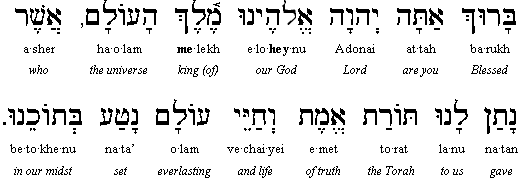Blessing the Torah Before Reading the Torah... Recommend this page to a friend. Being called up for the Torah blessing is considered a great honor in most synagogues. This being called up is called making or getting an aliyah. What's involved in making aliyah la'Torah? Each Shabbas, a weekly portion from the Torah (called a parashah) is chanted during morning services. This Torah portion itself is further divided into smaller sections called aliyot (literally, "ascents"), and it is customary to call up people from the congregation to recite a blessing before and after each section is recited by the cantor or Torah reader. For Shabbas services each parashah is divided in seven aliyot with a concluding portion (called the Maftir) recited by the person who will also recite the Haftarah blessings. This means that during a given Shabbas Torah Reading service, eight people will be called to recite blessings over the Torah. If you have been given the honor of being called up for an aliyah, you will chant the blessings before and after the reading of the Torah (by the cantor). Here is a brief guide to performing this honor:
Definitions: Aliyah - (f.; pl. "Aliyot"); going up, rising; ascent; in location or in personal qualities; as in "Aliyah l'Eretz Yisrael," "going up to live in the Land of Israel" or "Aliyah La'Torah," "going up to make a blessing on the Torah." For a given (Shabbas) Torah reading service there are seven aliyot recited (that is, seven different portions of the weekly parashah that are recited during the Torah Reading service). Bimah: (n) A platform from which Torah is read (usually in front of the Ark, but in Sephardic synagogues it may be in the center of the room). Mazal Tov (inter.) "Congratulations" An expression of congratulation or heartfelt well-wishes ("Mazel Tov on the new baby"). Tallis Gadol: (n) A four-cornered prayer shawl worn by adults during the morning prayers. Each corner of the Tallis Gadol has fringes, called tzitzis. Wearing the tallis helps get us in the mood for prayer. The third paragraph of the Shema prayer contains the commandment to wear tzitzis. At the top of a tallis is an atarah, or a band. The purpose of the atarah is to make sure we do not put the tallis on upside down (as well as to list the Hebrew blessing recited upon donning the tallis gadol). The atarah is removed when the tallis is used to bury the dead. Traditional Jews also wear a tallis katan (small tallis). It is also called the arbah kanfot (four corners), which is a special garment like an undershirt. It also has four fringed corners. For traditional Jews, only men wear the tallis gadol and tallis katan.
This'll bring us to the ... Navigator ... the heart of this site. |



